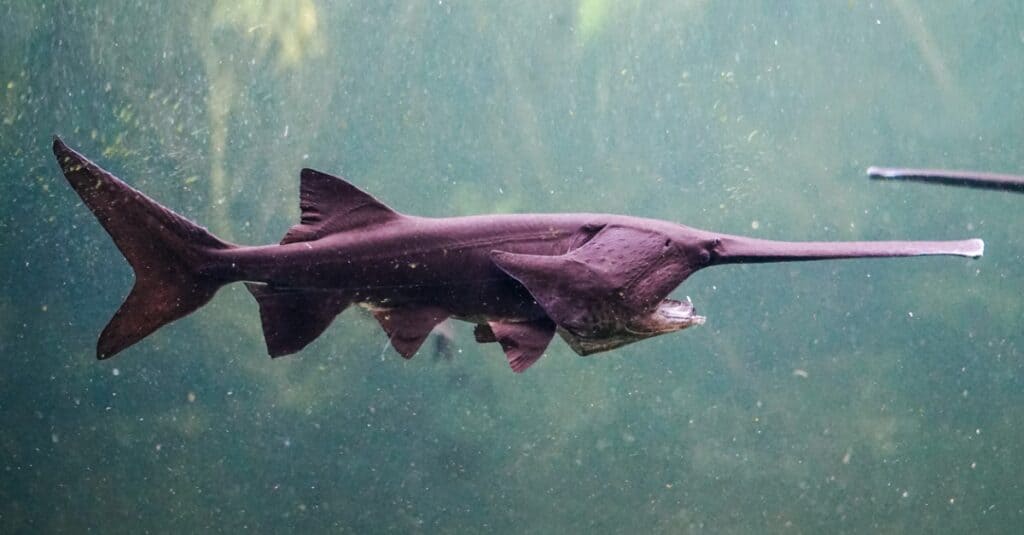At first glance, it might be difficult to tell the difference between a sawfish and a saw shark because they look so much alike. The sawfish and saw shark have long snouts with protruding teeth, which they use as weapons. These fish also have flat bodies and are bottom-dwelling, sharing similar profiles as they are distant cousins. Additionally, both sawfish and saw sharks are cartilaginous. However, the sawfish is a ray, while the saw shark is a true shark. Finally, sawfish have gills on the underside and saw sharks have gills on their sides. Even though they share similar traits, these fish are very different from one another. So, in this article, we explore sawfish vs. sawshark differences.

Sawfish vs. Sawshark: Sawfish grow to 25 feet and weigh 700 pounds whereas Sawsharks grow to 5 feet long and weigh 18 pounds. Both fish use their rostrums for hunting.
©PX Media/Shutterstock.com
Comparing the Sawfish and Sawshark
| Fish Facts | Sawfish | Sawshark |
|---|---|---|
| Scientific Name | Pristis Pectinata/Pristis Perotteti | Pristiophorus Cirratus/Pristiophorus Nudipinnis |
| Length | 18 – 25 feet | 5 feet |
| Weight | Up to 700 pounds | 18 pounds |
| Lifespan | 25 to 30 years | Up to 10 years |
| Reproduction | 10 to 20 live young | 3 to 22 live young |
| Range | Shallow, coastal waters. U.S., Mexico, Indian Ocean | At a depth of 40 – 100 meters Indian Ocean, Southern Pacific, Caribbean |
| Diet | Small fish and crustaceans | Small fish, crustaceans, and squid |
| Conservation Status | Endangered | Least concern |
Sawfish and Sawshark: Size
Sawfish are large fish, easily measuring up to 25 feet long. These fish can easily weigh 700 pounds or more. Even though sawfish are very large, they don’t prey on humans.
On the other hand, saw sharks grow to around 5 feet long. In addition, saw sharks have record weights of 20 pounds. These sharks mainly prey on small fish and crustaceans and do not threaten humans.
Sawfish vs. Saw Shark: Behavior
Sawfish use their saw or rostrum for hunting because it is full of sensitive pores that pick up electrical currents. These pores are known as Lorenzini’s ampullae. The electric currents they produce make it easier for the sawfish to pick up vibrations in the water, especially when it is murky and they cannot see their prey. However, when attacking schools of fish, it waves its saw from side to side like a sword. The sweeping motion of the rostrum stuns its prey.
Some species of saw sharks live in schools, while others prefer to be solitary. Saw sharks hunt their prey using their saws to cripple them with a sweeping action. A saw shark’s rostrum also features sensory organs known as ampullae of Lorenzini, like the sawfish, to detect electrical currents.
Where To Find the Sawshark and Sawshark?
Sawfish are bottom-dwelling, living in shallow coastal waters and even inhabiting rivers and lakes. But you will primarily find them in tropical and subtropical areas. At one point, these fish were widespread. However, steep declines in their numbers have led to some species becoming regionally extinct. But you will still find the sawfish swimming in the waters around Florida, the remainder of the U.S., and northern Australia.
Shawsharks live in deep waters on the seabed, primarily at depths of 40 to 100 meters. However, the Bahamas saw shark can easily live at depths of 900 meters. They populate the continental shelves of temperate, tropical, and subtropical oceans. Moreover, some saw shark species are migratory in response to the fluctuating seasonal temperatures.
Diets of Saw Sharks vs Sawfish
Sawfish and saw sharks share a similar diet. They both hunt for small fish and crustaceans. However, sawfish eat only small fish that fit in their mouths. Also, sawfish and saw sharks hunt in the same way. They thrash their heads from side to side, using their rostrums to stun their prey. Saw sharks eat small squid in addition to fish and crustaceans. Because they are nocturnal, sawfish have poor eyesight. However, Saw sharks have barbels on either side of their rostrums to help them find food. Sawfish lack these barbels and rely solely on their keen saws to help them find food.

Sawfish vs sawshark rostrums – sawfish rostrums have evenly spaced permanent teeth on each side of their saws, which don’t regrow when lost. Sawsharks have barbels growing from their saws and their teeth regrow when lost.
©Nick Fox/Shutterstock.com
Reproduction
Very little is known about sawfish reproduction. However, these fish are believed to be ovoviviparous, meaning the female gives birth to live young. And because no one has seen sawfish reproduction behavior, they estimate that they produce 10 to 20 young at a time. Also, these fish mature slowly and don’t appear to reproduce frequently.
Saw sharks mate every two years during the mating season. Female saw sharks have a gestation period of 12 months. After this period, they give birth to live young, with litters between three and 22 pups. Saw sharks reach sexual and reproductive maturity after two years. Their shorter lifespan and shorter reproduction time are one of the reasons the saw shark isn’t under threat of extinction.
Saws and Teeth
The sawfish and saw shark have a saw or rostrum on their faces that are a part of their skulls and actually elongated noses. While both species share this feature, their saws are very different.
Sawfish rostrums have teeth along both sides. The number and size of teeth vary between species. However, they are permanent, so they won’t regrow if they lose them. Sawfish teeth grow from the bottom like a rodent. Their teeth are evenly spaced and similar in size, and they often sharpen them in the sand.
Like their cousins, saw sharks have teeth on both sides of their saw. In addition, barbels stick out from the rostrum. The saw shark uses these barbels to feel around for food in the sand.
Their teeth, like those of most sharks, grow back when lost. Because of this feature, saw sharks look unkempt as their teeth are often at different growth lengths.
Sawshark vs Sawfish: Conservation Status
All five species of the sawfish are critically endangered or on the IUCN’s endangered list. This is because people hunt sawfish for their fins to make shark fin soup. In addition, some people use their teeth, rostrums, and other parts in traditional medicine—furthermore, sawfish face habitat loss. Since 2007, CITES has restricted international trade in sawfish and their parts, they are also protected in several countries, and anyone hunting them faces hefty fines if caught.
Most species of saw sharks are not endangered. But, the common saw shark is an exception, making it onto the IUCN’s list as a near-threatened species.
The photo featured at the top of this post is © Bonnie Taylor Barry/Shutterstock.com
Thank you for reading! Have some feedback for us? Contact the AZ Animals editorial team.







